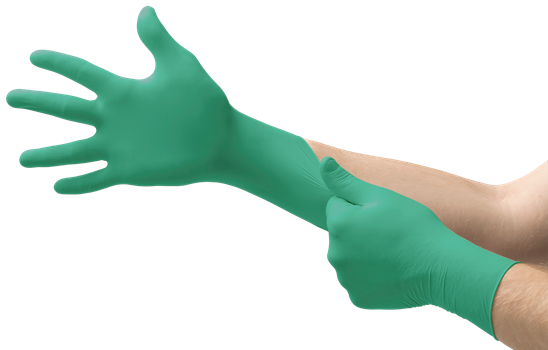
This image has format transparent PNG with resolution 548x350.
You can download this image in best resolution from this page and use it for design and web design.
Medical gloves PNG with transparent background you can download for free, just click on download button.
Medical gloves are disposable gloves used during medical examinations and procedures to help prevent cross-contamination between caregivers and patients. Medical gloves are made of different polymers including latex, nitrile rubber, polyvinyl chloride and neoprene; they come unpowdered, or powdered with cornstarch to lubricate the gloves, making them easier to put on the hands.
Cornstarch replaced tissue-irritating Lycopodium powder and talc, but even cornstarch can impede healing if it gets into tissues (as during surgery). As such, unpowdered gloves are used more often during surgery and other sensitive procedures. Special manufacturing processes are used to compensate for the lack of powder.
There are two main types of medical gloves: examination and surgical. Surgical gloves have more precise sizing with a better precision and sensitivity and are made to a higher standard. Examination gloves are available as either sterile or non-sterile, while surgical gloves are generally sterile.
Besides medicine, medical gloves are widely used in chemical and biochemical laboratories. Medical gloves offer some basic protection against corrosives and surface contamination. However, they are easily penetrated by solvents and various hazardous chemicals, and should not be used for dishwashing or otherwise when the task involves immersion of the gloved hand in the solvent.
Generally speaking, examination gloves are sized in XS, S, M and L. Some brands may offer size XL. Surgical gloves are usually sized more precisely since they are worn for a much longer period of time and require exceptional dexterity. The sizing of surgical gloves are based on the measured circumference around the palm in inches, at a level slightly above the thumb's sewn. Typical sizing ranges from 5.5 to 9.0 at an increment of 0.5. Some brands may also offer size 5.0 which is particularly relevant to women practitioners. First-time users of surgical gloves may take some time to find the right size and brand that suit their hand geometry the most. People with a thicker palm may need a size larger than the measurement and vice versa.
Research on a group of American surgeons found that the most common surgical glove size for men is 7.0, followed by 6.5; and for women 6.0 followed by 5.5
To facilitate donning of gloves, powders have been used as lubricants. Early powders derived from pines or club moss were found to be toxic. Talcum powder was used for decades but linked to postoperative granuloma and scar formation. Corn starch, another agent used as lubricant, was also found to have potential side effects such as inflammatory reactions and granuloma and scar formation.
Due to the increasing rate of latex allergy among health professionals, and in the general population, gloves made of non-latex materials such as polyvinyl chloride, nitrile rubber, or neoprene have become widely used. Chemical processes may be employed to reduce the amount of antigenic protein in Hevea latex, resulting in alternative natural-rubber-based materials such Vytex Natural Rubber Latex. However, non-latex gloves have not yet replaced latex gloves in surgical procedures, as gloves made of alternative materials generally do not fully match the fine control or greater sensitivity to touch available with latex surgical gloves. (High-grade isoprene gloves are the only exception to this rule, as they have the same chemical structure as natural latex rubber. However, fully artificial polyisoprene—rather than "hypoallergenic" cleaned natural latex rubber—is also the most expensive natural latex substitute available.) Other high-grade non-latex gloves, such as nitrile gloves, can cost over twice the price of their latex counterparts, a fact that has often prevented switching to these alternative materials in cost-sensitive environments, such as many hospitals. Nitrile is a synthetic rubber. It has no latex protein content and is more resistant to tearing. Also it is very resistant to many chemicals and is very safe for people who are allergic to latex protein. Nitrile gloves are the most durable type of disposable gloves. Although nitrile gloves are known for their durability, extra care should be taken while handling silver and other highly reactive metals because those substances can react with sulfur, an accelerant in nitrile gloves.
In this page you can download free PNG images: Medical gloves PNG images free download